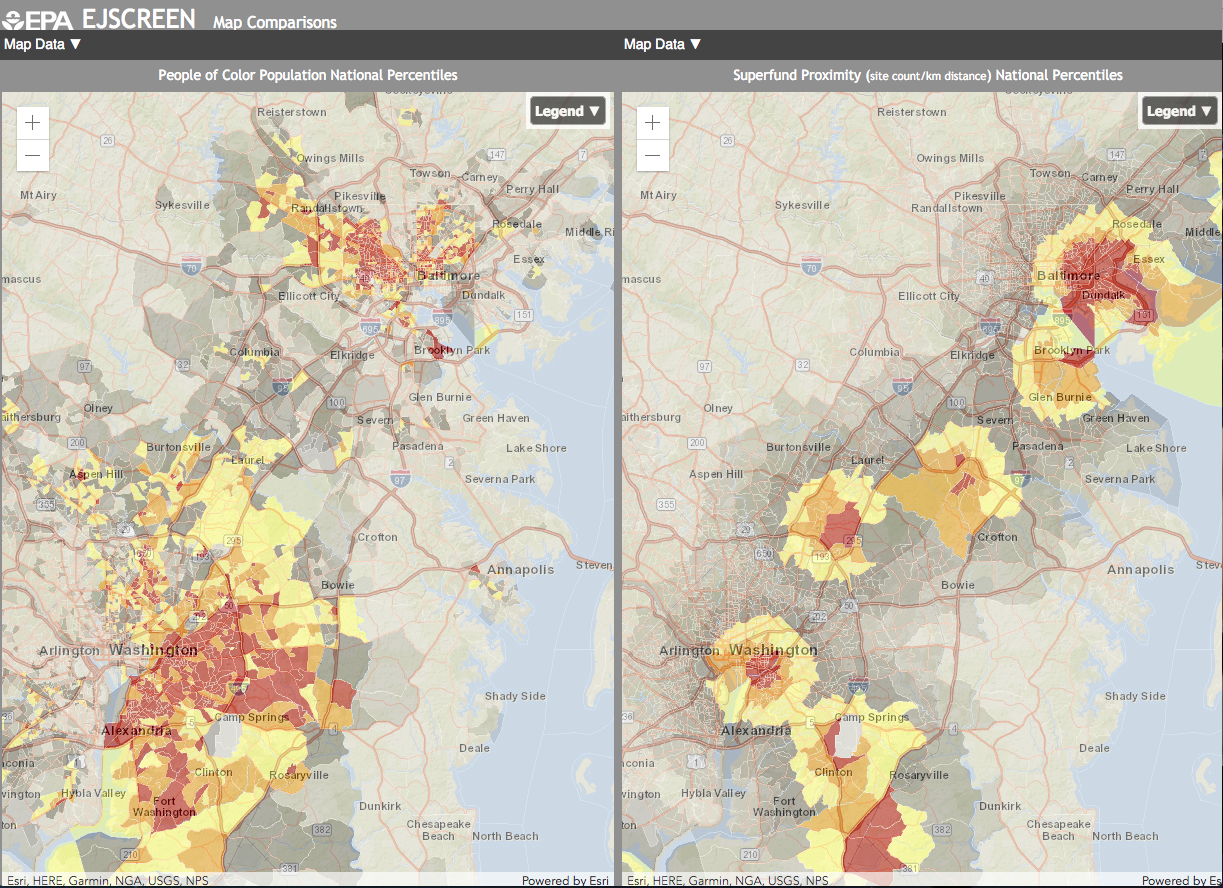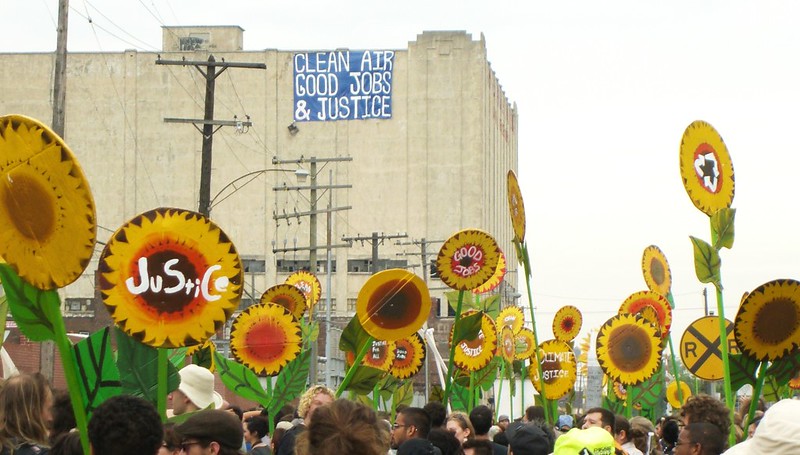Race and Environmental Justice
Amber Fandel ·We cannot discuss, measure, or address environmental justice without acknowledging and understanding the role of race. Even when all other socioeconomic factors are the same, race is still the most important factor in determining whether a person will be exposed to hazardous waste (Bullard, 1993; Smith, 2016). This is environmental racism, and it is not a new problem. The placement of these hazardous waste facilities may be the result of a lack of resistance from communities of color that typically have less political power than their white counterparts (Solomon, Maxwell, & Castro, 2019), zoning that was historically racially motivated (Shertzer, Twinam, & Walsh, 2016), or lower property values in non-white neighborhoods (Howell, 2020) (property values that will further decrease after the placement of the hazardous waste facility). Whatever the reason, race plays a vital role.

This week, our class delved further into which indicators should be included in our Chesapeake Bay Environmental Justice Report Card. These indicators are measures of the physical, social, economic, environmental, political, and governance characteristics of our communities and will be used to show the current and future states of environmental justice. Therefore, it is vital that we choose indicators and specific levels of those indicators that are measurable, can change over several years, and, most importantly, can capture the environmental injustices experienced by communities. It is clear that race will be a lens through which we will have to view every indicator.
The Chesapeake Bay watershed is historically, culturally, and physically associated with the Chesapeake Bay. It is therefore fitting that one group in our class has decided to investigate commercial and recreational fishing as a potential indicator of environmental justice. This indicator could include access to fishing piers, fishing licensing, and the spatial and racial information of fishing captains. These data may be difficult to come by and may not capture subsistence fishing (fishing to feed one’s family and not for selling), but are important to consider given the culture of the bay.
Poverty levels (households below the federal poverty level of $12,880 for individuals and $26,500 for a family of four) and the locations of subsidized public housing will also have to be considered in measuring environmental justice. People in these groups have minimal ability to move. Therefore, they cannot control the hazards to which they are exposed. Again, race should be considered and compared against these indicators.
One of the first environmental justice cases in the United States was the Warren County, North Carolina protest against a hazardous waste landfill in a predominantly African-American neighborhood (Fears & Dennis, 2021).Residents were unable to stop the construction of that landfill. Exposure to hazardous waste remains a primary concern in environmental justice today and will likely be included in the report card.

As we are focusing on the Chesapeake Bay as the foundation for our environmental justice analysis, it would be fitting that we examine where funds for restoration projects are being allocated. This is our “follow the money” indicator. In a preliminary analysis of which areas receive funding to improve environmental management practices, wealthier voting districts seem to be favored.
Finally, in considering race itself as an indicator, we should consider communities of color not only as a whole, but also according to their individual identities. Identifying which communities are suffering from which environmental injustices will be critical in properly assessing and addressing them. Whether or not we include indicators that measure access to recreational or commercial fishing, hazardous waste sites, subsidized public housing, or poverty levels, race must be considered and compared against any indicator of environmental access and equity.
References
Bullard, R. D. (1993). Race and Environmental Justice in the United States. Yale J. Int'l L., 18, 319. https://digitalcommons.law.yale.edu/yjil/vol18/iss1/12
Fears, D. & Dennis, B. (2021, April 6). How a protest in a Black N.C. farming town nearly 40 years ago sparked a national movement. Washington Post. Retrieved from www.washingtonpost.com/climateenvironment/interactive/2021/environmental-justice-race/
Howell, J. (2020, September 24). Race determines home values more today than it did in 1980. The Kinder Institute for Urban Research. Retrieved from kinder.rice.edu/urbanedge/2020/09/24/housing-racial-disparities-race-still-determines-home-values-America
Shertzer, A., Twinam, T., & Walsh, R.P. (2016). Race, Ethnicity, and Discriminatory Zoning, American Economic Journal: Applied Economics, 8(3), 217-246. doi: http://doi.org/10.1257/App.20140430
Smith, M. D. (2016, February 18). Race Best Predicts Whether You Live Near Pollution. The Nation. Retrieved from www.thenation.com/article/archive/race-best-predicts-whether-you-live-near-pollution/
Solomon, D., Maxwell, C., & Castro, A. (2019, August 7). Systematic Inequality and American Democracy. Center for American Progress. Retrieved from www.americanprogress.org/issues/race/reports/2019/08/07/473003/systematic-inequality-american-democracy/
About the author
Amber Fandel

Amber Fandel is a second year Master’s student who has worked at the University of Maryland Center for Environmental Science’s Chesapeake Biological Lab since 2017. Her work has focused on conservation and environmental education efforts throughout the country. She currently examines how human and natural sounds affect marine mammals, and is determining the impacts of offshore wind energy development on these animals. She is pursuing a career in environmental policy and aims to include environmental and social justice in all policy.
Next Post > Facilitating a Great Barrier Reef partnership workshop in Brisbane
Comments
-
Sarah 5 years ago
I loved the direction you went with this blog. We have highlighted many indicators in our course, but race is definitely the most important and essential indicator of environmental justice. I also appreciated that you included recreational and commercial fishing due to our focus in the Chesapeake Bay area.
-
Isabel Sullivan 5 years ago
Great blog! I appreciate that you provided sources that provided the background of our class and EJ issues that have been present across the country. In your last paragraph, you hit on the important note that we need to use these indicators to determine what communities are facing EJ issues. I especially think this point is relevant given that our class is planning to engage stakeholders in these vulnerable communities.
-
Katrina Kelly 5 years ago
You hit on some powerful points, Amber. Nice job! Two of my favorites (1) “follow the money” indicator and (2) "consider communities of color not only as a whole, but also according to their individual identities" are essential nuances to the environmental justice issue in America, because outcomes around money and race within our capitalist framework are never coincidental.
-
Taylor Gedeon 5 years ago
Important point about determining which indicators/hazards/injustices are being experienced by the different communities we interact with. Such an important benefit of meaningful community engagement and collaboration.
-
Andrea M Miralles-Barboza 5 years ago
Great point about not homogenizing BIPOC communities. Although I appreciate that a term exists, I think sometimes really different identities and experiences get lost in this process. Thanks for sharing :)
-
Faith Taylor 5 years ago
Great job Amber! Everything was well said
-
Chelsea Richardson 5 years ago
Race is definitely a strong predictor of environmental hazard. Racial minorities are more often exposed to environmental threats than their white counterparts of the same social class and I like that you highlighted this.
-
Megan Munkacsy 5 years ago
Great blog - thanks for summarizing a lot of class information!
-
Amanda Rockler 5 years ago
Great summary of the journey that is defining and refining report card indicators.
-
Ashley Silver 5 years ago
I agree with race being an indicator. We can connect race to the other indicators to see which neighborhoods are directily exposed to environmental injustices.
-
Olivia Wolford 5 years ago
This was a great summary, I appreciate that it included both historical context and the importance of race and environmental justice within the Chesapeake Bay specifically.
-
Jehnae Linkins 5 years ago
Race is one of the most important indicators. Race can be related back to almost anything, especially the other indicators.
-
Imani Black 5 years ago
Great blog Amber! These conversations and continuously bring race to the forefront will only help everyone reach a more compassionate understanding of everyone's experiences, personally and environmentally.
-
Haoyu(Peter) Chen 5 years ago
Great interpretation of the topic. Race is one of the most significant factors of EJ. I also agree that some unique indicators to CB watershed is needed to be included more like mentioned commercial and recreational fishing. And this needs more meetings and discussion with stakeholders around CB in order to get informations.
-
Shakira 5 years ago
Amber, this was a great blog. The picture of the rally in Detroit represents this post well. "Exposure to hazardous waste remains a primary concern in environmental justice" I like that you spoke on this topic as well.
-
Imani Wilburn 5 years ago
I love how you highlight race in all of these issues. I also love how you presented this issue into your blog.
-
Nylah McClain 5 years ago
When we bring up “following the money” it always makes me wonder how we will appeal to more economic-favoring stakeholders in a way that will make them want to “share the wealth” rather than hoard it. Identifying where the location of wealth is one thing, but I think future members of this class will have a wild time convincing those in power to disseminate said power and wealth for the betterment of all.

